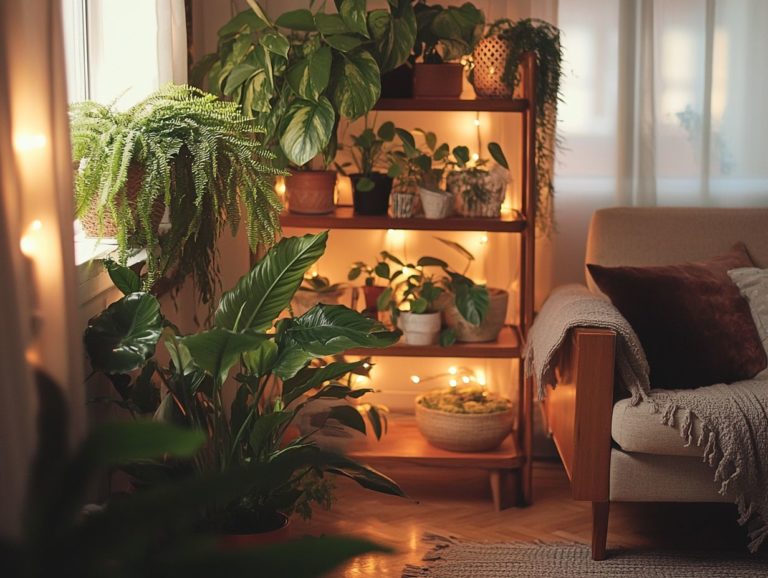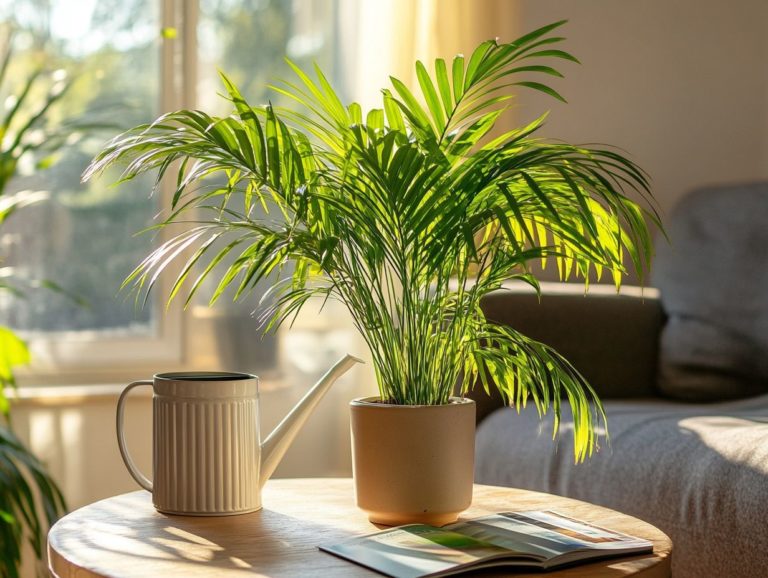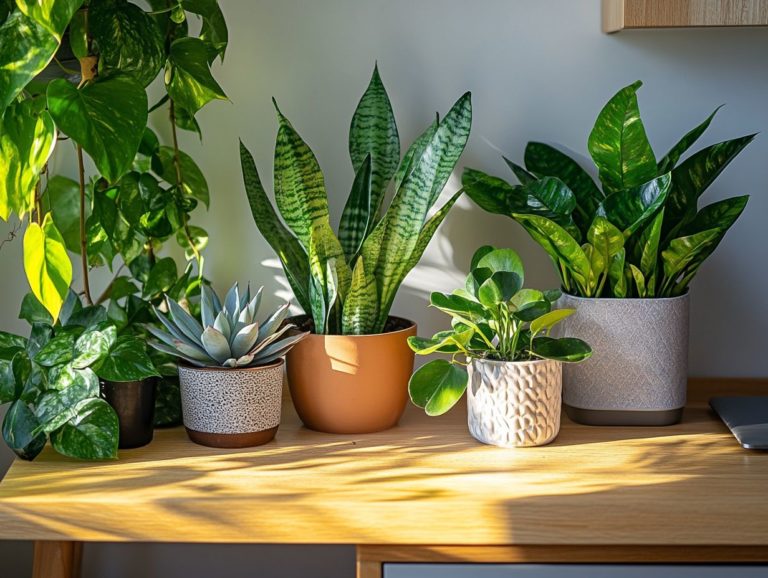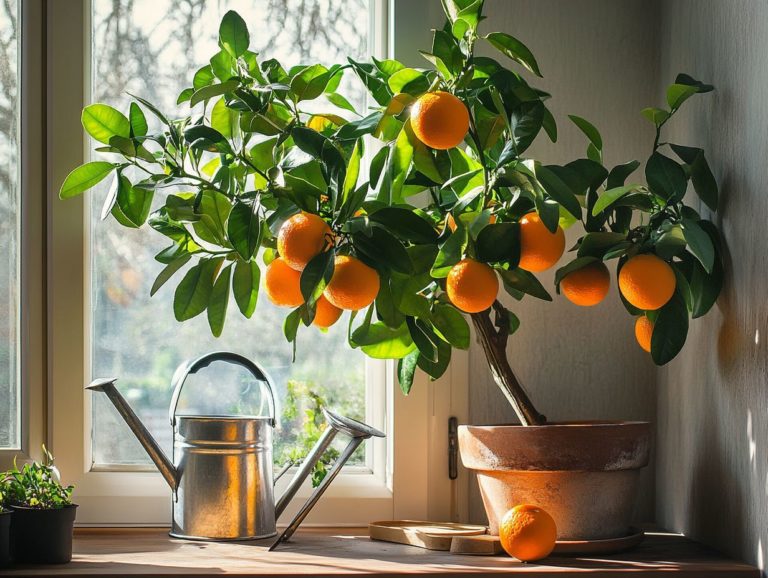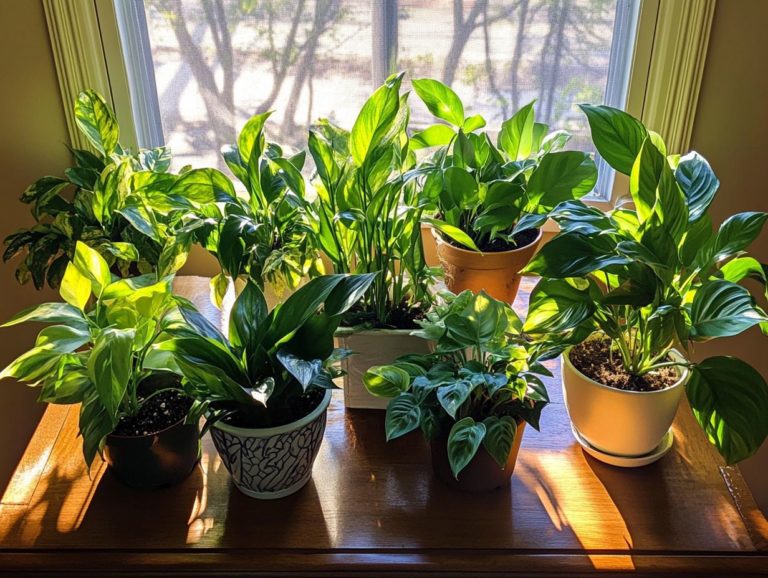Understanding the Care of Indoor Zinnias
Indoor zinnias bring vibrancy to any space. Their striking colors and joyful blooms make them a perfect addition.
Explore how to select the right zinnias for your indoor oasis. Learn to create the perfect environment and master the essentials of watering, feeding, and pruning.
You ll learn about common pests and diseases that can challenge your gardening journey, along with expert tips for transitioning your zinnias outdoors when the time is right.
Whether you re a seasoned gardener or just starting out, this guide equips you with all the knowledge you need to cultivate thriving indoor zinnias.
Contents
- Key Takeaways:
- Choosing the Right Zinnias for Indoor Care
- Setting Up the Ideal Environment for Indoor Zinnias
- Watering and Feeding Indoor Zinnias
- Pruning and Maintaining Indoor Zinnias
- Common Pests and Diseases for Indoor Zinnias
- Preparing Indoor Zinnias for Outdoor Growth
- Transplanting and Adjusting to Outdoor Conditions
- Frequently Asked Questions
- What are some key things to know about caring for indoor zinnias?
- Can I grow zinnias as houseplants indoors all year round?
- How often should I water zinnias indoors?
- Why are the leaves of my indoor zinnias turning yellow?
- Do indoor zinnias need to be pruned?
- Are indoor zinnias prone to zinnia diseases or pests?
Key Takeaways:
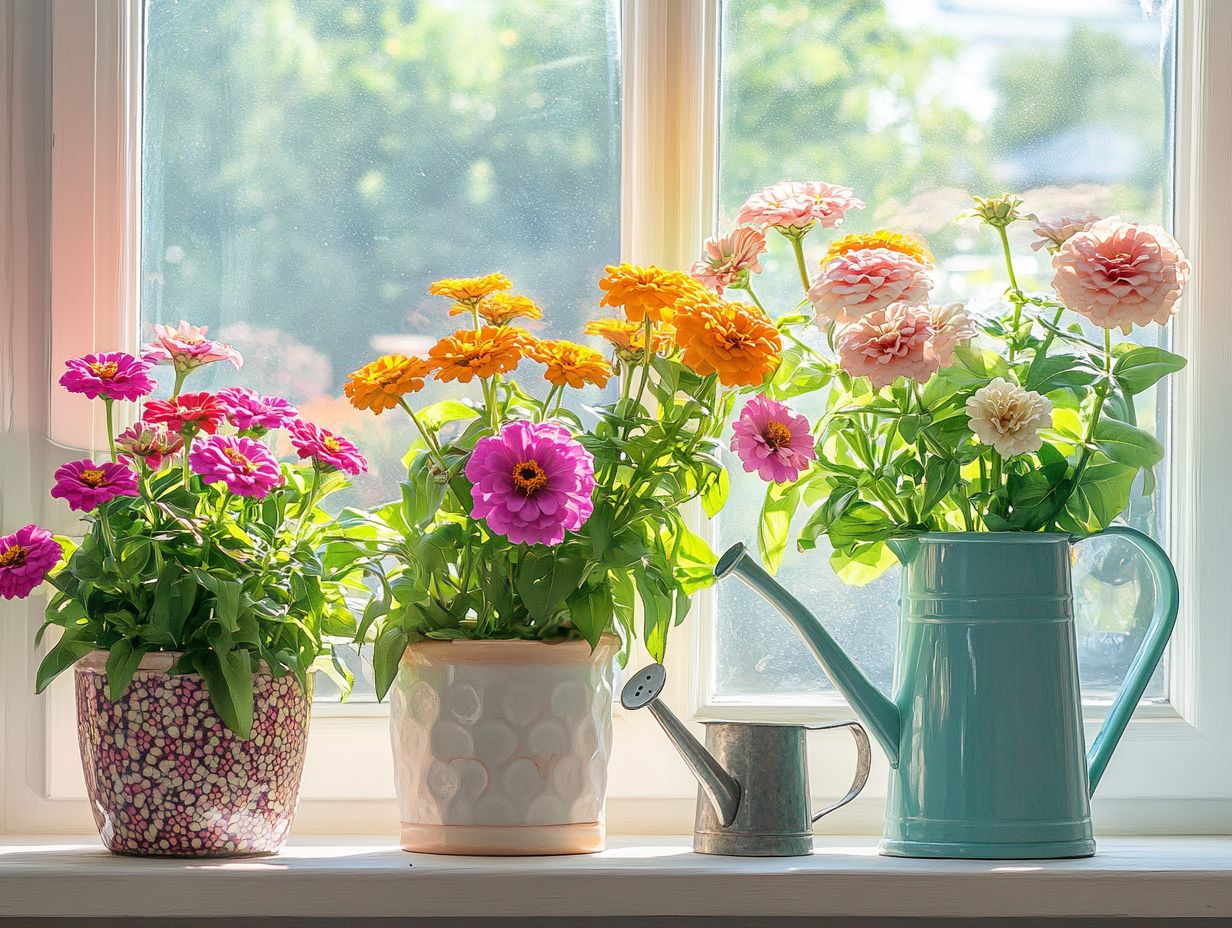
- Choose the right type of zinnias for your indoor space and their specific needs.
- Create the ideal environment by providing adequate light, temperature, and humidity for indoor zinnias.
- Proper watering, feeding, pruning, and maintenance practices are crucial for the health of your zinnias.
What are Indoor Zinnias?
Indoor zinnias, or Zinnia elegans, are vibrant flowering companions belonging to the Asteraceae family. They are adored for their colorful blooms and effortless care. These annual flowers infuse your indoor spaces with cheer and thrive when given the right attention to their light, water, and soil conditions.
Their adaptability makes them perfect for avid indoor gardening enthusiasts and anyone looking to enhance their home s aesthetics with stunning potted flowers.
To keep these delightful plants healthy and vibrant, proper zinnia care tips are essential. This ensures they continue to bring joy and color into your living environment.
What makes indoor zinnias truly special are their resilient nature and impressive variety of colors from bold reds to soft pastels that add a splash of personality to any space. They flourish best in bright, indirect sunlight and thrive in well-draining soil that retains just the right amount of moisture.
You ll find that cultivating zinnias is a breeze. A simple watering routine and the occasional sprinkle of fertilizer typically do the trick. These colorful zinnias brighten your mood and make eye-catching centerpieces, making them a beloved choice for both novice and seasoned indoor gardeners alike.
Choosing the Right Zinnias for Indoor Care
Choosing the right zinnias for your indoor space is essential for creating a vibrant environment for these charming flowers. With a plethora of zinnia varieties available, you can select options that align perfectly with your aesthetic preferences and care capabilities.
Consider potted zinnias like the Benary Giant, Thumbelina, and Zahara Starlight Rose; each brings its unique flair and requires specific care tips to truly thrive indoors. Engaging with zinnia experts or visiting reputable gardening centers can offer valuable insights, guiding you toward the varieties that will harmonize beautifully with your indoor gardening aspirations.
Types of Zinnias and Their Needs
Among the many zinnia varieties available, you’ll find the Mexican Zinnia, Oklahoma Zinnia, State Fair Zinnia, and Cactus Zinnia. Each boasts unique characteristics and specific care requirements that cater to diverse indoor gardening preferences.
For instance, the Mexican Zinnia is renowned for its drought resistance and ability to thrive under various conditions, while the Cactus Zinnia captivates with its spiky petals, adding a charming touch to any indoor flower garden.
Understanding these needs is crucial for successful zinnia propagation and overall plant health. For optimal growth, the Mexican Zinnia flourishes best in full sunlight, requiring at least six hours of direct light each day, and thrives in well-drained, sandy soil that reflects its native habitat.
On the other hand, the Oklahoma Zinnia prefers a tad more moisture, adapting well to various soil types and flourishing in loamy conditions that retain just the right amount of water without becoming soggy.
The State Fair Zinnia is a showstopper, standing tall with similar light and soil requirements as the Mexican variety, but it appreciates a touch of moderate humidity. Meanwhile, the Cactus Zinnia revels in warm temperatures and demands less watering, thriving on sparse irrigation to prevent rot.
As it basks in the sun, it showcases its vibrant, textured blooms, truly making it a standout in your indoor garden.
Setting Up the Ideal Environment for Indoor Zinnias
To cultivate healthy indoor zinnias, create an environment with the right light, temperatures, and humidity. These flowering beauties thrive on at least 6 hours of bright sunlight each day.
Keep the temperature between 70-75 F. This comfortable range will support robust growth and vibrant blooms.
Light, Temperature, and Humidity Requirements
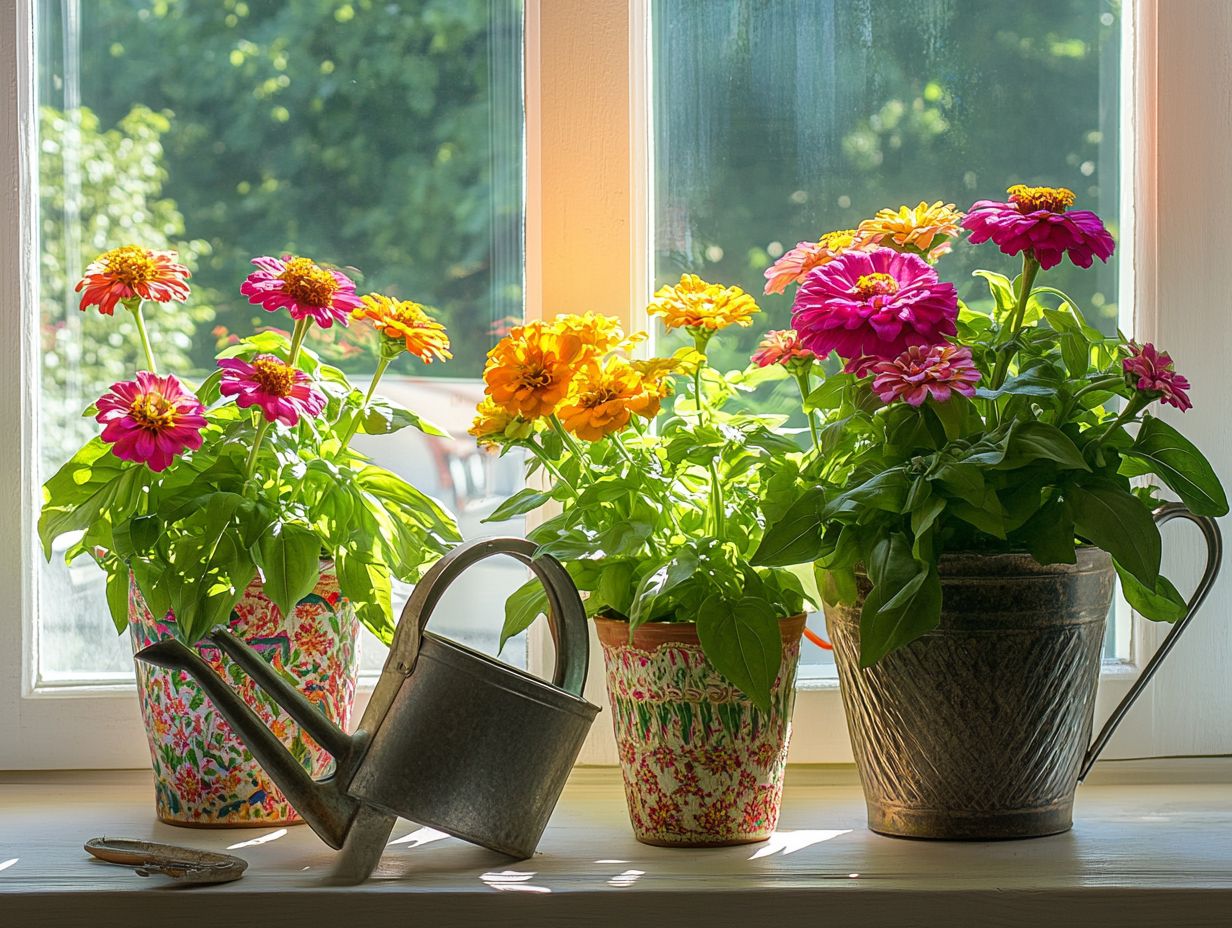
Light, temperature, and humidity are crucial for zinnia care. Zinnias flourish best under bright light, so use grow lights if natural sunlight isn t enough.
Maintain a consistent temperature and moderate humidity to ward off pests and diseases. This leads to healthy zinnias that bloom beautifully.
Invest in full-spectrum LED grow lights. They provide essential wavelengths for growth and can be easily adjusted.
Aim to keep the temperature between 65 F and 75 F. For humidity, try a small humidifier or cluster your plants to create a nurturing area.
Check soil moisture regularly. Water only when the top inch feels dry to avoid overwatering, ensuring vibrant blooms and a flourishing garden.
Watering and Feeding Indoor Zinnias
Successful indoor zinnia cultivation relies on effective watering and feeding practices. Master these techniques for optimal health and vibrant blooms.
Water your zinnias thoroughly. Allow the soil to dry slightly between sessions to prevent root rot.
Use high-quality plant food at the right times. This significantly boosts growth and flowering potential.
Proper Techniques and Timing
Understand the best techniques and timing for watering and feeding zinnias. This is vital during critical growth stages like seed germination and blooming.
At the germination stage, keep the soil consistently moist but not soggy. Excess water can hinder seed development.
Once the flowers sprout, water gently to encourage deep root growth. A soaker hose or drip irrigation works well.
During blooming, increase watering in hotter months. Regular deadheading will promote continued flowering!
Pruning and Maintaining Indoor Zinnias
Pruning and maintaining your indoor zinnias is essential for fostering healthy growth and extending their flowering periods. These practices are integral to effective zinnia care.
By regularly removing faded blooms, you not only encourage new growth but also elevate the visual appeal of your plants, allowing you to relish their vibrant colors for an extended time.
Moreover, utilizing proper pruning techniques will help you manage the size and shape of your zinnia plants. This further promotes their overall development and health throughout their lifecycle.
Trimming and Removing Faded Blooms for Optimal Growth
Trimming and removing faded blooms are vital aspects of zinnia maintenance. These practices greatly influence the health and vibrancy of your indoor plants.
By consistently removing faded blooms, you stimulate further flowering and optimal growth. Utilizing these techniques aligns perfectly with effective gardening practices and helps prevent zinnia diseases.
For effective trimming, it’s best to use sharp scissors or pruning shears to make clean cuts just above a leaf junction or where the flower stem meets the main plant. This meticulous method minimizes any damage to surrounding foliage, ensuring the zinnia plants remain healthy.
Make it a point to carry out this task regularly ideally once a week to ensure that wilted flowers are swiftly removed! Removing yellowing leaves improves air circulation, which is essential for warding off fungal issues and helping your zinnia blooms flourish.
By consistently caring for your indoor zinnias in this manner, you can maximize their blooming potential and maintain their vibrant, healthy appearance, enhancing the aesthetics of your indoor gardening.
Common Pests and Diseases for Indoor Zinnias
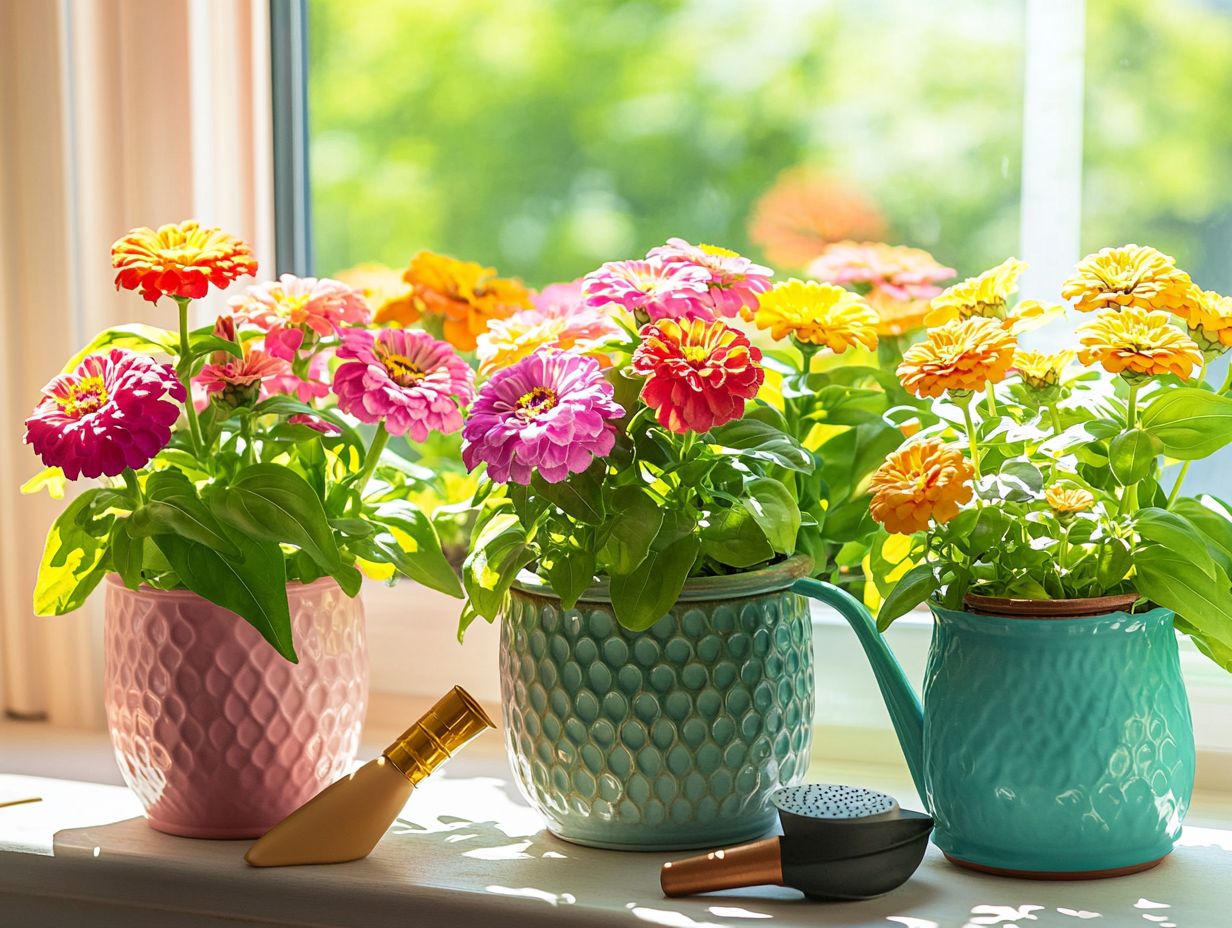
Knowing common pests and diseases is key to keeping your zinnias healthy and vibrant.
Your indoor zinnias can attract pests like aphids and spider mites, alongside diseases such as powdery mildew. By recognizing the signs of these issues early and employing targeted care tips for zinnias, you can mitigate their impact and cultivate a thriving indoor garden that flourishes beautifully.
Identifying and Treating Issues
Spotting and fixing problems with your zinnias is crucial for maintaining their health and ensuring they flourish in your indoor garden. Common signs of distress, such as wilting leaves or discolored blooms, often indicate underlying problems related to pests or improper care.
By employing effective zinnia care strategies and seeking gardening advice when challenges emerge, you can promptly tackle these concerns, keeping your zinnias vibrant and thriving.
- One of your first steps in diagnosing problems is to closely inspect the leaves and stems for zinnia pests like aphids or spider mites. These can be effectively treated with insecticidal soap or neem oil.
- Be cautious of overwatering, as it can lead to root rot. Checking the moisture level of the potting mix before adding more water is crucial for healthy zinnia plants.
- Place your potted zinnias in bright, indirect sunlight to help prevent leggy growth and encourage robust zinnia blooms.
- Regularly remove dead flowers a process known as deadheading zinnias to stimulate further blooming.
- For persistent issues, such as severe zinnia pest infestations or mold, consulting a local horticulturist or garden center for specialized assistance is a wise choice.
Preparing Indoor Zinnias for Outdoor Growth
Preparing your indoor zinnias for outdoor growth takes careful planning to facilitate a seamless transition that nurtures their lifecycle and overall health. Since zinnias flourish in outdoor conditions, it’s crucial to gradually acclimate them to their new surroundings.
Start with short exposure times before transplanting them fully. This careful approach not only promotes zinnia propagation but also alleviates the stress that sudden environmental shifts can place on these cherished flowering plants.
Start caring for your zinnias today and watch them thrive!
Transplanting and Adjusting to Outdoor Conditions
Transplanting indoor zinnias to your outdoor garden requires careful planning and execution. This ensures their successful growth in a new environment. By following essential gardening tips like timing your transplanting with favorable weather and prepping the garden bed you can greatly enhance their chances of thriving outdoors.
Implementing zinnia care strategies during this transition will help minimize stress and promote overall health. Start by assessing your local climate, as the best time for transplanting zinnias is in the spring, right after the last frost date.
Before moving them outside, acclimate your zinnias to their new surroundings. This process, known as hardening off, involves gradually exposing your plants to sunlight and varying temperatures over a week.
Choosing a sunny spot in your garden with well-draining soil is crucial. When you’re ready, dig holes that comfortably fit the root ball of each zinnia. Ensure you space them adequately to avoid overcrowding.
After transplanting, maintain consistent watering. Consider adding a balanced fertilizer to nourish their growth, allowing for vibrant blooms throughout the season.
Frequently Asked Questions
What are some key things to know about caring for indoor zinnias?
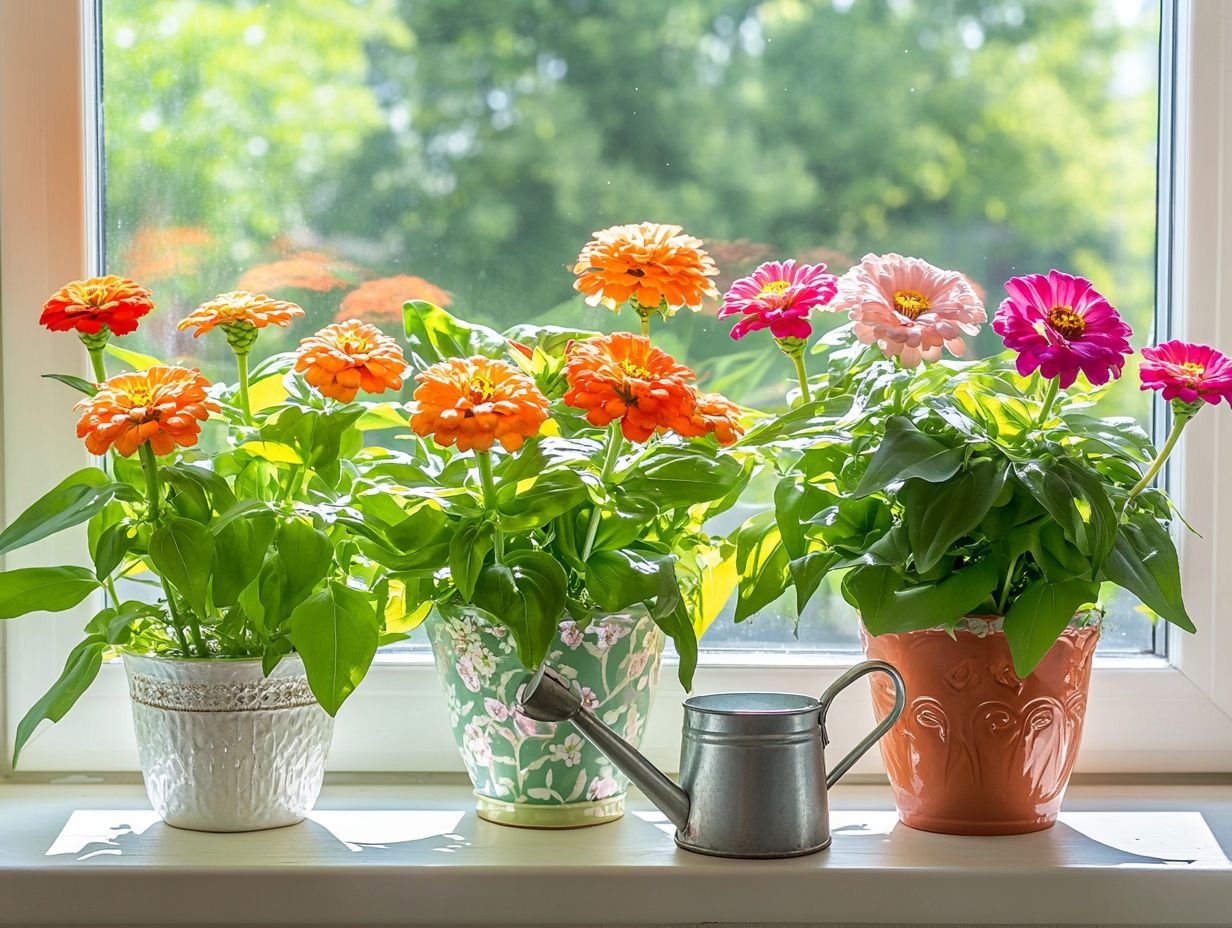
Understanding the care of indoor zinnias starts with knowing their preferred environment. They love soaking up bright, indirect sunlight and need consistent watering and well-draining soil.
These plants also appreciate occasional fertilization and deadheading of spent blooms to keep them healthy and vibrant.
Can I grow zinnias as houseplants indoors all year round?
While zinnias can grow indoors, they are annual plants and will eventually die after one growing season. You can prolong their lifespan with optimal care and by starting new plants from saved seeds.
How often should I water zinnias indoors?
Keep the soil of your indoor zinnias moist to ensure they flourish, but don t let it become waterlogged. Water them when the top inch of soil feels dry to the touch, typically 1-2 times per week depending on your home s temperature and humidity.
Why are the leaves of my indoor zinnias turning yellow?
Yellowing leaves can indicate over-watering or under-watering, as well as possible nutrient deficiencies. Check the soil moisture and consider adding a balanced fertilizer to address the issue.
Do indoor zinnias need to be pruned?
Pruning, or deadheading, spent blooms on indoor zinnias is not necessary. However, it can encourage more flowers and keep the plant looking tidy. Use clean, sharp scissors to snip off the spent blooms at the base of the stem.
Are indoor zinnias prone to zinnia diseases or pests?
Indoor zinnias are generally resilient and not prone to many pests or diseases. However, they may attract common houseplant pests like aphids or spider mites. Regularly inspect your plants and treat any infestations promptly with natural or chemical methods.

